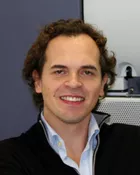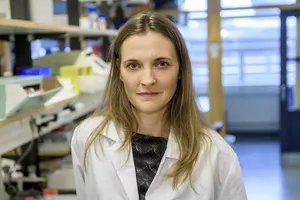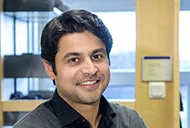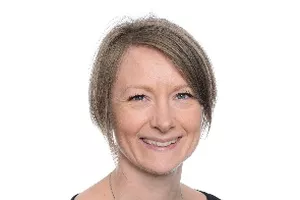WCMM Fellows
João Duarte
Wallenberg Molecular Medicine Fellow - Diabetes
Insulin signalling has a role in modulating brain function, namely through control of metabolism and synaptic plasticity, and its deterioration occurs in neurodegenerative disorders, such as Alzheimer’s disease (AD), and in diabetes mellitus.
We are mainly investigating the coupling between brain metabolism and function, and its deregulation in diabetes, as well as contributing to identify strategies for rescuing brain metabolic regulation in diabetes. Our research is focused on the hippocampus and cortex, which are brain regions involved in cognition, and on the hypothalamus, which has a major role in whole-body energy balance. Notably, since metabolic alterations are likely early events in the process of neurodegeneration, this line of research may provide early biomarkers to identify encephalopathy prior to severe loss of brain functions in diabetes patients.
Darcy Wagner
Wallenberg Molecular Medicine Fellow – Respiratory System
Over three million people die each year and over 60 million people suffer worldwide from chronic lung diseases (CLDs). At present, there is no cure for CLDs, including chronic obstructive pulmonary disease (COPD), pulmonary hypertension, and pulmonary fibrosis. Lung transplantation is the only option at end-stage disease and is further complicated by shortage in organs available for transplantation and low efficacy. Five-year survival rate has remained at 50% for the last decade. New options are desperately needed for these patients.
Our lab focuses on understanding the role of the extracellular environment for endogenous and exogenous lung tissue regeneration in healthy and diseased lung. In particular, our work focuses on the design and use of biologic and synthetic scaffolds to bioengineer new lung tissue for transplantation. We further aim to build new models of human lung tissue to reduce animal usage, better understand how regeneration processes are deranged in CLDs, and for use as drug discovery and therapeutic screening platforms.
- More information about Darcy Wagner in Lund University Research Portal
- Watch a movie about her research (Youtube, opens up in a new window)
Filipe Pereira
Wallenberg Molecular Medicine Fellow – Hematopoietic System
The focus of our lab is to understand the molecular determinants underlying cellular reprogramming and hematopoietic specification. Cellular reprogramming can be achieved experimentally in different ways, including nuclear transfer, cell fusion or expression of transcription factors. The emergent ability to reprogram differentiated cells into desired hematopoietic cell-types is opening avenues to the discovery of new therapies for immune and blood diseases.
The goals of my laboratory are a) to understand at the molecular level how hematopoietic cellular identities are specified employing cellular reprogramming logic and b) to use this knowledge to manipulate genes and pathways that ultimately may allow the generation of patient-specific hematopoietic cells for regenerative medicine and immunotherapy.
- More information about Filipe Pereira in Lund University Reseach Portal
- Watch a video about his research (Youtube, opens in a new window)
Anja Meissner
Wallenberg Molecular Medicine Fellow – Cardiovascular System
Cardiovascular disease such as heart attack, stroke, and peripheral vascular disease, is the number-one health problem in the world. Despite remarkable progress in diagnosis and prevention, cardiovascular diseases cause disability and death at an astounding rate. The best opportunities to develop and implement new strategies for preventing and treating cardiovascular disease lie in the understanding of its underlying mechanisms.
Thus far, our earlier work provides ample evidence that S1P plays a key role in immune cell recruitment, cytokine production and vascular tone regulation during experimental hypertension and heart failure. Therefore, we strongly believe that S1P’s signalling axis will prove an attractive therapeutic target for cardiovascular complications.
Our research aims to isolate novel therapeutic targets that effectively prevent and most importantly, also reverse complications mediated by cardiovascular risk factors such as hypertension. Specifically, we are interested in sphingosine-1-phosphate (S1P) signalling and its role in the regulation of the vascular and the immune system.
- More information about Anja Meissner in Lund University Research Portal
- Read about Gustav Smith and Anja Meissner in LUM magasin nr 6, 2017
Iben Lundgaard
Wallenberg Molecular Medicine Fellow – Nervous System
Despite the brain’s high level of metabolic activity the central nervous system (CNS) does not contain any lymphatic vessels. The cerebrospinal fluid (CSF) is driven into peri-vascular spaces where exchange of solutes takes place and this mediates brain-wide clearance. The peri-vascular bulk flow system was named the glia-lymphatic (glymphatic) system due to the crucial role of astrocytes’ aquaporin 4 (AQP4) water channels. The glymphatic system is akin to the lymphatic system and also connects with the conventional lymphatic system upon drainage from the CNS. Due to the drainage to lymph nodes, it is believed that the glymphatic system is important for CNS immune function.
Our lab is interested in the glymphatic system due to its function as a macroscopic clearance system. Among specific research topics at the Lundgaard laboratory is the role of the glymphatic system in neurodegenerative diseases, such as Parkinson’s disease, and in CNS immunity including the autoimmune disease multiple sclerosis.
Paul Bourgine
Wallenberg Molecular Medicine Fellow – Musculoskeletal System
Bone is a complex Organ providing structural and mechanical support of our body, but also consisting in our principal hematopoietic center. The formation of our bones is tightly and timely orchestrated, involving stages of cartilage, vasculature, bone and bone marrow establishment. My lab aims at compiling human-specific knowledge on how these tissues form, interact and regenerate at an organ scale, toward the development of innovative regenerative therapies. Precisely, we exploit Bone organogenesis as a paradigm to decipher the driving cellular and molecular mechanisms. Toward this objective, we develop cutting-edge in vitro / in vivo models offering the custom design of human skeletal tissues & organs:
(i) The in vivo formation of human bone organs
(ii) The in vitro engineering of bone marrow models in 3D culture systems
(iii) The design of grafts for skeletal tissue regeneration using death-inducible mesenchymal lines
Clinical implications of our research run from the repair of bone and cartilage defects, the expansion/differentiation of human blood cells for transplantation, and the screening of drugs for blood cancer treatment.
- More information about Paul Bourgine in Lund University Research Portal
- Watch a video about his research (Youtube, opens in a new window)
Vinay Swaminathan
Wallenberg Molecular Medicine Fellow – Cancer
Cells in our body exist not only in a diverse biochemical environment but also in a highly dynamic and complex mechanical environment such as blood flow, muscle contraction-relaxation, stiffness of different organs and the extra-cellular matrix. Starting from embryogenesis, tissue development and differentiation to immune, cardiovascular, musculoskeletal and brain function, the mechanical environment plays an important role in all these processes. Not surprisingly, breakdown or mis-regulation of the interactions between cellular functions and the mechanical environment results in many pathologies including disease progression in a number of different cancers.
The goal of my lab is to understand the cellular and molecular mechanisms by which cells interact with their mechanical environment and how mis-regulation of these interactions results in tumor progression and metastasis. We are primarily focused but not limited to investigating the effect of this environment on the process of cell migration and cancer metastasis. Our approach is to develop and use quantitative microscopy techniques as well as tools from engineering and physics to build in-vitro cancer models and extend knowledge gained from these fundamental mechanistic studies to more clinically relevant cancer models.
Niklas Mattsson
Wallenberg Molecular Medicine Fellow – Nervous System with Emphasis on Plasticity and Function
Alzheimer’s disease (AD) is a common neurodegenerative disease, which causes immense suffering for tens of millions of patients and their relatives, and huge financial burdens for societies worldwide. Despite intense research efforts, there is still no cure or disease-modifying treatment for AD. This is partly due to a lack of understanding of the earliest events in the disease, and how the different components of the disease cascade are linked together.
My research is focused on the earliest stages of AD. In particular, I am interested in understanding the mechanisms of beta-amyloid and tau accumulation, which are neuropathological hallmarks of AD. There are still many mysteries regarding why beta-amyloid and tau accumulate. For example, the accumulation appears to follow largely predictable spatiotemporal patterns, but why do these processes start? And what underlies the selective vulnerability in different brain regions? Another unsolved question is how beta-amyloid and tau are linked together. For example, beta-amyloid accumulation appears to be necessary for the detrimental spread of tau across the brain, but why? It is also not clear how beta-amyloid or tau actually cause injury to synapses and neurons. For example, how closely correlated are accumulation of beta-amyloid and tau with synaptic and neuronal loss? And what determines the variability in these correlations? Are there especially toxic forms of beta-amyloid or tau that are responsible for the injury, or are other components also necessary?
Being part of WCMM will help me to develop more advanced approaches to study these basic pathophysiological questions. I utilize a variety of experimental systems for my studies, including advanced biochemical and neuroimaging testing in human volunteers, genetic studies, and cell biology experiments. I am also interested in translating my findings into tools to manage brain injuries in general, including in other neurodegenerative diseases and brain injury after cardiac arrest.
- More information about Niklas Mattsson in the Lund University Research Portal
- Watch a movie about his research (Youtube, opens in nyew window)
Agnete Kirkeby
Wallenberg Molecular Medicine Fellow - Advanced Therapy for Medical Products
The human brain is a highly complex structure, consisting of hundreds of different subtypes of neural cells; each of which fulfil a specific function in the brain network. When some of these neurons are lost – such as in neurodegenerative diseases – our brains become malfunctioning. The goal of our research is to develop stem cell-based neural cell therapies to replace lost neurons as a treatment for brain diseases. In particular, we focus as a main project on the development of a pluripotent stem cell product (ATMP) for treatment of Parkinson’s Disease.
Our research also focuses on understanding basic human brain development. In the Kirkeby lab, we apply advanced human stem cells models and single cell RNA sequencing to understand how the hundreds of human neural subtypes of cells are formed during embryo development. With this knowledge at hand, we become better at controlling the differentiation of human pluripotent cells to subtype-specific neurons which can be used for disease modelling, drug screening and transplantation, leading to new treatments for several types of brain disorders.
- More information about Agnete Kirkeby in the Lund University Research Portal
- Watch a movie about her research (Youtube, opens in new window)
Nick Leigh
Wallenberg Molecular Medicine Fellow - Regenerative Medicine
There is tremendous variation in how different species respond to injuries. Following an injury, humans are able to heal wounds, but are left with a scar. This limited regenerative ability is also seen following the amputation of a limb, where humans are unable to regenerate following amputation. In contrast, salamanders are able to fully regenerate limbs following amputation. The reasons for why salamanders are able to regenerate entire limbs and humans cannot are not understood. A marked difference between salamanders and humans is how the immune system responds to injury. Our lab will focus on understanding how the immune system is able to facilitate regeneration. This interdisciplinary approach will employ concepts and techniques from immunology and regenerative biology as well as cutting edge ‘omics-based approaches to uncover immune system-derived requirements for scar-free healing and regeneration. The funding provided by the Wallenberg Centre for Molecular Medicine Lund University (WCMM LU) will allow me to start an independent position and lab that focuses on this important but understudied area of regenerative biology. Further, WCMM LU provides an ideal environment to facilitate collaboration with other scientists focused on regeneration and importantly provides a direct link to clinical collaborations which will ensure our research impacts patients. In the future, this work will lay the foundation for therapies and interventions designed to harness the immune system to promote regenerative responses in patients.
- Watch a movie about his research (Youtube, opens in new window)











